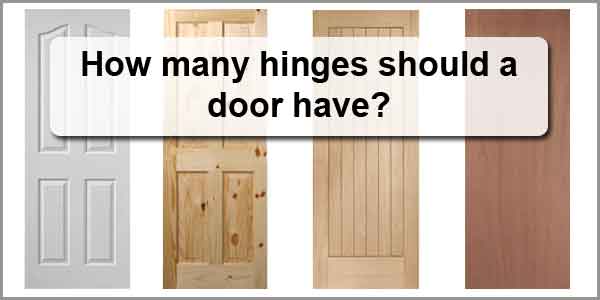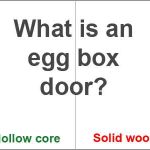When hanging a new door you have several things to consider. These include things like:
- The types of locks, latches, and handles.
- Which way the door will open? in or out, left or right?
- Will the door need shortening to account for flooring
- How much needs planing off
- Etc
Another thing that can be confusing, is how many hinges you need per door. Is it two? Or is it three? The answer is actually not that complicated.
Generally, the amount of hinges a door needs, is determined by the weight of the door. In general, a relatively light internal door will only need two hinges. Other things, like the size of the door and potential exposure to moisture, can also affect the decision.

For external doors, such as the front door on your house, three hinges would always be used. This is due to several different reasons:
- Firstly, the weight of external doors is often significantly heavier than internal doors. This means, a third hinge provides extra strength and stability to the door.
- Next, external doors will be exposed to outside weather. This added moisture can increase the potential for warping in wooden doors. A third hinge will reduce the ability for your door to move.
- And finally security. A third hinge makes the door much stronger. This will make breaking into the property with force harder.
Internal doors on the other hand, have different requirements. They are used for dividing and accessing rooms internally, so weather and security are not an issue. The main thing that effects the number of hinges on internal doors is the doors weight.
When to use 2 or 3 hinges on internal doors
In most cases, two hinges will be adequate for internal doors. If the doors are hollow core, you definitely don’t need three hinges. These doors are so light that a third hinge would be completely unnecessary.
If you are installing solid doors, you may in some cases need a third hinge.
For a relatively light softwood door, made from something like pine, two hinges will usually still be fine.
However, you may decide to use a third hinge on bathroom doors. This is mainly due to extra moisture, which can cause the door to twist and warp. By adding a third hinge, you strengthen the door and stop it from moving due to excess moisture.
As you can see, both hollow core doors and pine doors are pretty lightweight. This means there is less requirement to add a third hinge. These two make up the majority of internal doors, and as a result, this means most internal doors will only have two hinges.
However, whilst these are the most common, they are not the only types of doors. There are also hardwood doors, fire doors, and other heavy solid core doors. These will all usually need to use three hinges.
Should oak doors have 3 hinges
Oak is the most popular hardwood used in internal doors. This is mainly due to its relatively low price compared with other hardwoods. It is also a beautiful type of wood, which gives a more aesthetic finish than a basic pine, hollow core, or moulded door.
Just like any hardwood door, the weight is likely to be considerably heavier. For this reason, you will want to use three hinges. The third hinge will give additional strength and support to the extra weight in this type of door.
The problem with two hinges on a hardwood door, such as oak, is it will be much more prone to sagging. Even with hinges cut into the door casing, the hinges can still pull down. Plus the screws are under more strain and can pull away from their fixing into the casing.
This doesn’t mean that your door will fall off. Instead it will usually end up sticking, on either the floor or the handle side of the door. A third hinge placed in the middle, will take a lot of the extra strain, and avoid these kinds of problem.
How many hinges are needed on a fire door
Just like hardwood doors, fire doors need three hinges. However, this is not just a recommendation, it is a legal requirement. The minimum fire rating of a fire door is 30 minutes, during this time, extreme heat and pressure is being applied to the door.
The hinges need to hold up without failing as well. Due to this, not only do you need three hinges, but you also need fire rated hinges and screws to secure the door.
Fire door hinges are bigger than standard hinges. They are usually 4 inches (100mm), and they are thicker than a standard hinge. Also, they are made from high grade stainless steel. This combined with extra-large screws, mean the hinges are able to withstand very high temperatures, heavy weights, and additional pressure.
Fire door hinges will also be marked with CE and an additional stamp that shows the are fire rated.
Door hinge positions for 2 and 3 hinge doors
Door hinge positions will vary slightly depending on who you ask. Generally, the top hinge will be 6 inches from the top of the door, and the bottom hinge will be 8-9 inches from the bottom.
If you are fitting a door in a property, that already has doors installed, you should check and match the positioning of these hinges.
Finally if you are adding a third hinge, you should place it in the middle of the door. This should be evenly spaced between the top and bottom hinges.
Conclusion
Whether you choose two or three hinges, will usually depend on the weight of the door. A lighter door, such as a hollow core door, really has no need for a third hinge. Depending on size, these doors can be as light as 15kg.
For a standard pine 4 panel door, you could bump this up to 20kg. Again this is pretty light, and two hinges is more than enough.
However, once you start moving up to solid hardwood doors, the weights start going up considerably (30kg+). Fire doors are often even heavier, with a standard fire door weighing anywhere from 30-45kg.
With this amount of extra weight, a third hinge will help to strengthen your door. Plus, as we mentioned previously, it is a legal requirement for fire doors.




